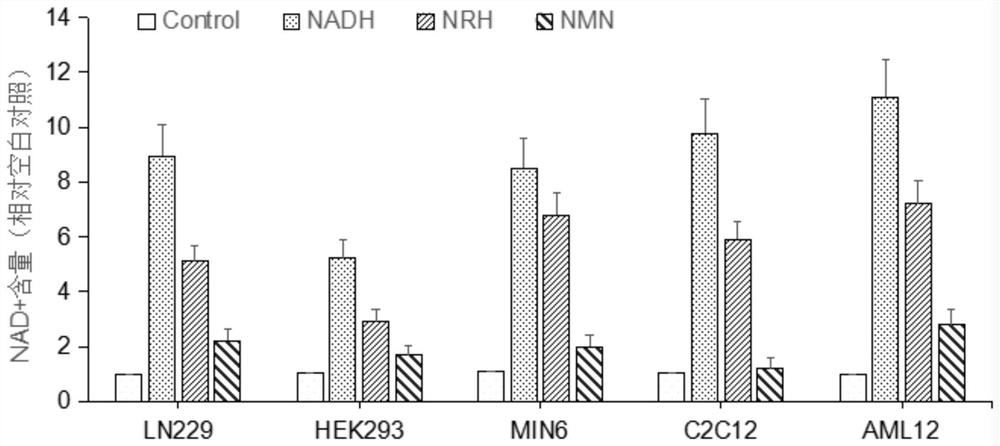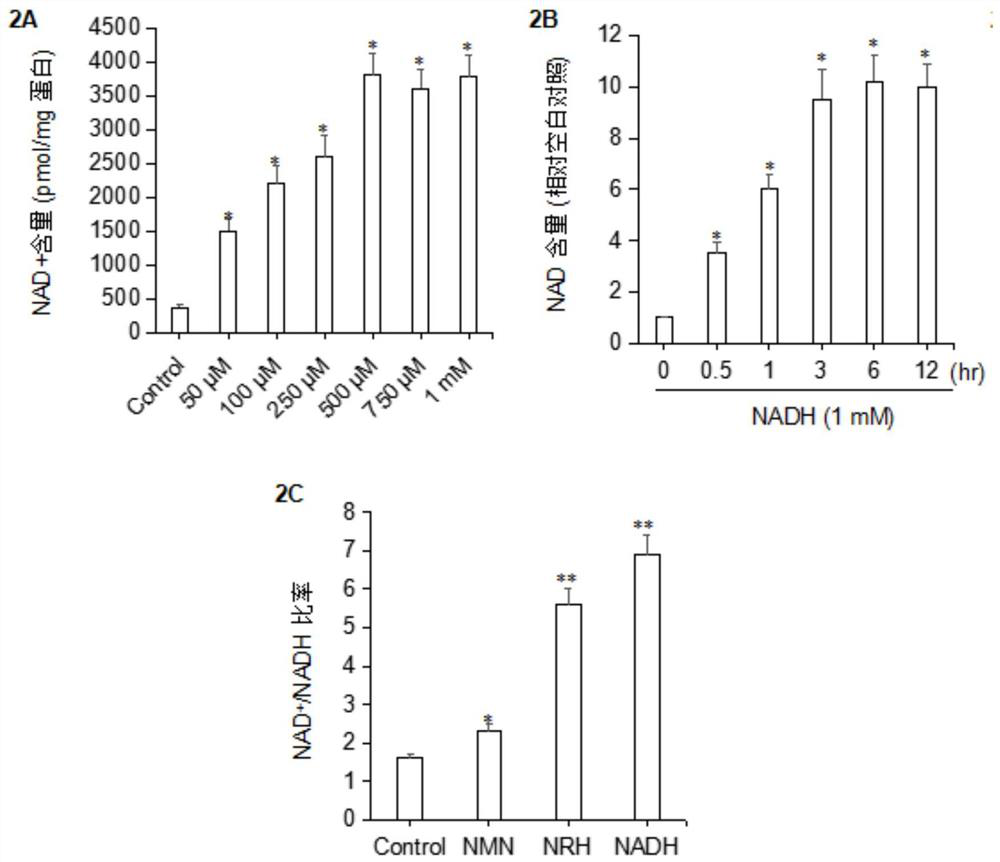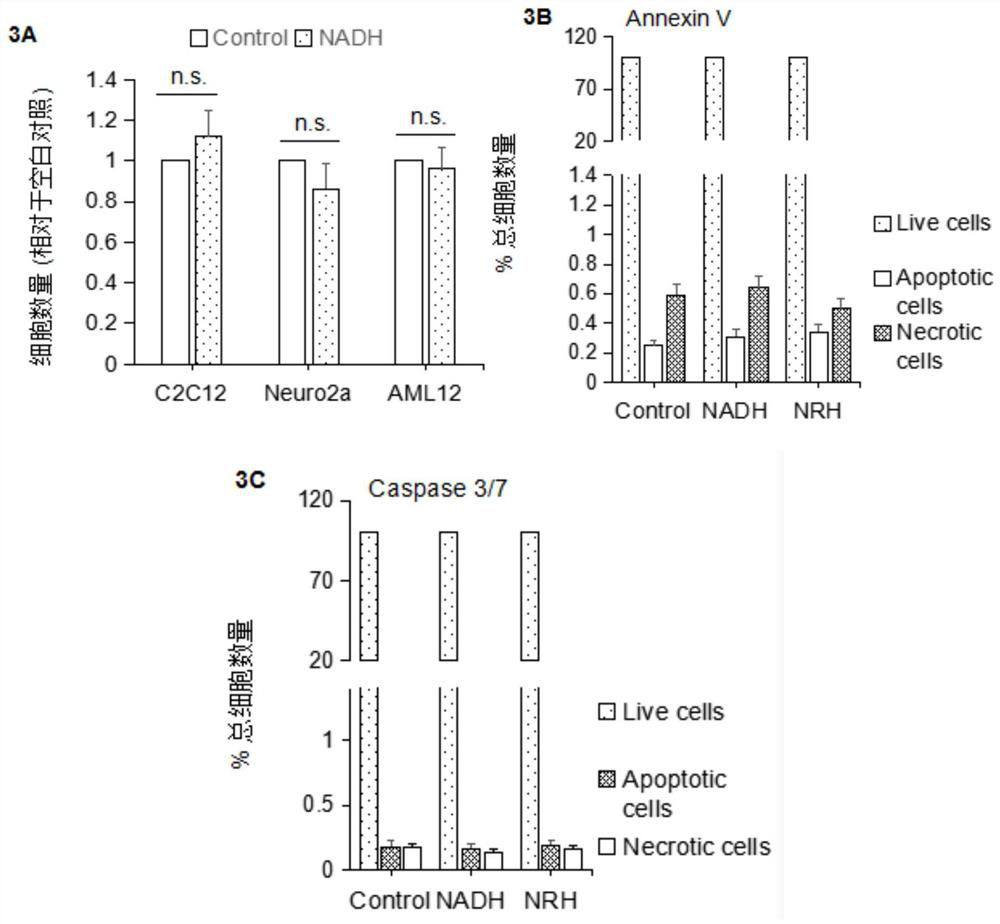Application of NAD+ supplement in preparation of medicine for treating acute alcoholic liver injury
A technology for alcoholic liver damage and supplements, applied in the field of medicine, can solve problems such as lack of liver damage, and achieve the effects of eliminating hangovers, preventing and hangovers, and improving alcohol tolerance
- Summary
- Abstract
- Description
- Claims
- Application Information
AI Technical Summary
Problems solved by technology
Method used
Image
Examples
Embodiment 1
[0072] Example 1 Elevation of NAD+ Concentration Caused by NADH and NRH Intake
[0073] To explore whether NADH can be taken up by cells and alter NAD+ concentration, mammalian cell lines such as proinsulin cells (MIN6), neuron-like cells (LN229), muscle-like cells were treated with vehicle (control), 1mmNADH, 1mmNRH or 1mm NMN (C2C12), normal liver cells (AML12) and HEK293 cells for 3 hours.
[0074] Cells were seeded in 6-well plates until reaching approximately 80% confluency. Cells were incubated with indicated concentrations of NADH, NRH or NMN and harvested by trypsinization. NADH or NRH were treated for 3 hours unless otherwise stated. Count the number of cells by hemocytometer and trypan blue. Harvested cells were then pelleted at 3000 g for 3 min. After removing the residual medium, the preserved NAD+ was dissolved with 7% perchloric acid, and then neutralized with NaOH (2m) and K2HPO4 (500mm). The determination of intracellular NAD+ concentration is consistent w...
Embodiment 2
[0079] Low toxicity and remedial effect in the genotoxicity of embodiment 2
[0080] A sharp increase in NAD+ concentration indicates possible toxicity to cells. To assess this toxicity, C2C12, Neuro2a and AML12 cells were treated with 1 mm NADH for 24 h, and then the total cell number was measured. Specifically, C2C12, Neuro2a and AML12 cells were incubated with 1 mM NADH or NRH for 24 h and then dissociated by trypsin for cell counting. Cells were stained with trypan blue and counted with a hemocytometer. To detect apoptosis of AML12 cells, PBS, 1 mmNADH or NRH were added to 6-well plates and treated for 24 hours. Cell numbers were counted with a BD FACSCelesta flow cytometer using Annexin v / PI staining kit and Caspases3 / 7 / SYTOX dead cell staining kit (Life Technologies). Quadrants of apoptotic, necrotic, and viable cells were identified and quantified according to the manufacturer's instructions.
[0081] image 3 A is a graph of these results, data are presented as me...
Embodiment 3
[0087] Example 3 NADH in vivo experiment
[0088] In the following in vivo experiments, C57BL / 6J male mice (Jackson Memorial Laboratory) (40 days old) were used. Under standard laboratory conditions, the temperature is 22±1°C, the photoperiod is 12 / 12h, and the relative humidity is 55±5%. All animals had free access to food and water, except for designated fasting periods (and where not indicated during the 2 h fasting period prior to dosing).
[0089] In order to evaluate the biological effects of NADH on mice, C57BL / 6J mice were intraperitoneally injected with NADH 1000 mg / kg, and the content of NAD+ in tissues was measured 4 hours later. Specifically, ten 8-week-old male C57BL / 6J mice (Jackson Memorial Laboratory) were housed in polycarbonate cages with free access to food and water under a 12-h light / dark cycle. The mice were randomly divided into treatment group and control group. The treatment group was intraperitoneally injected with 1000 mg / kg NADH or NRH dissolved i...
PUM
 Login to View More
Login to View More Abstract
Description
Claims
Application Information
 Login to View More
Login to View More - R&D
- Intellectual Property
- Life Sciences
- Materials
- Tech Scout
- Unparalleled Data Quality
- Higher Quality Content
- 60% Fewer Hallucinations
Browse by: Latest US Patents, China's latest patents, Technical Efficacy Thesaurus, Application Domain, Technology Topic, Popular Technical Reports.
© 2025 PatSnap. All rights reserved.Legal|Privacy policy|Modern Slavery Act Transparency Statement|Sitemap|About US| Contact US: help@patsnap.com



